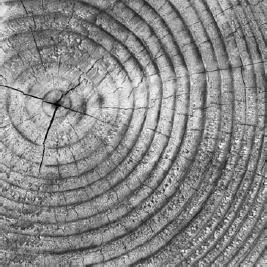The study of tree rings is known as dendrochronology. Every year, trees produce an annular ring composed of one wide, light ring and one narrow, dark ring. During spring and early summer, tree stem cells grow rapidly larger, thus producing the wide, light ring. In winter, growth is greatly reduced and cells are much smaller, producing the narrow, dark ring. In the coldest part of winter or the dry heat of summer, no cells are produced. Comparing pieces of dead trees of unknown age with the rings of living trees allows scientists to establish the date when the fragment was part of a living tree. This technique has been used to date the ancient pueblos throughout the southwestern United States. A subfield of dendrochronology is dendroclimatology. Scientists study the tree rings of very old trees to determine climatic conditions of the past. The effects of droughts, pollution, insect infestations, fires, volcanoes, and earthquakes are all visible in tree rings.

